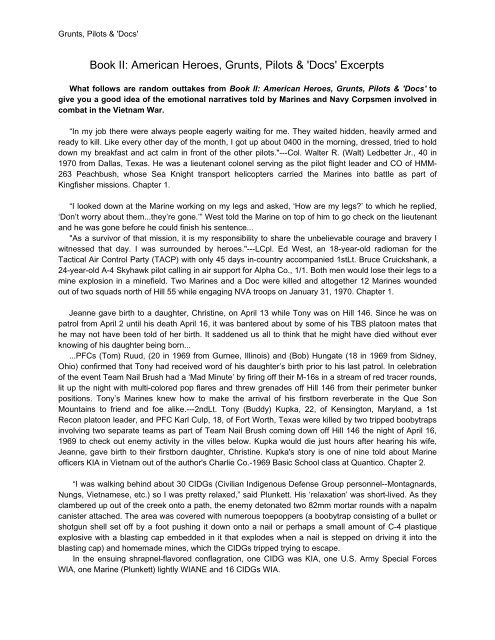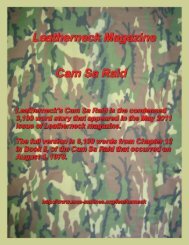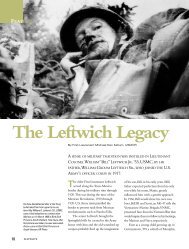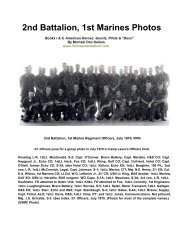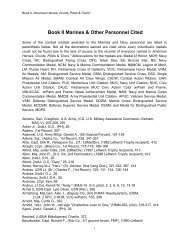Book II: American Heroes, Grunts, Pilots & 'Docs' Excerpts
Book II: American Heroes, Grunts, Pilots & 'Docs' Excerpts
Book II: American Heroes, Grunts, Pilots & 'Docs' Excerpts
Create successful ePaper yourself
Turn your PDF publications into a flip-book with our unique Google optimized e-Paper software.
<strong>Grunts</strong>, <strong>Pilots</strong> & <strong>'Docs'</strong><br />
<strong>Book</strong> <strong>II</strong>: <strong>American</strong> <strong>Heroes</strong>, <strong>Grunts</strong>, <strong>Pilots</strong> & <strong>'Docs'</strong> <strong>Excerpts</strong><br />
What follows are random outtakes from <strong>Book</strong> <strong>II</strong>: <strong>American</strong> <strong>Heroes</strong>, <strong>Grunts</strong>, <strong>Pilots</strong> & <strong>'Docs'</strong> to<br />
give you a good idea of the emotional narratives told by Marines and Navy Corpsmen involved in<br />
combat in the Vietnam War.<br />
“In my job there were always people eagerly waiting for me. They waited hidden, heavily armed and<br />
ready to kill. Like every other day of the month, I got up about 0400 in the morning, dressed, tried to hold<br />
down my breakfast and act calm in front of the other pilots."---Col. Walter R. (Walt) Ledbetter Jr., 40 in<br />
1970 from Dallas, Texas. He was a lieutenant colonel serving as the pilot flight leader and CO of HMM-<br />
263 Peachbush, whose Sea Knight transport helicopters carried the Marines into battle as part of<br />
Kingfisher missions. Chapter 1.<br />
“I looked down at the Marine working on my legs and asked, ‘How are my legs?’ to which he replied,<br />
‘Don’t worry about them...they’re gone.’” West told the Marine on top of him to go check on the lieutenant<br />
and he was gone before he could finish his sentence...<br />
"As a survivor of that mission, it is my responsibility to share the unbelievable courage and bravery I<br />
witnessed that day. I was surrounded by heroes."---LCpl. Ed West, an 18-year-old radioman for the<br />
Tactical Air Control Party (TACP) with only 45 days in-country accompanied 1stLt. Bruce Cruickshank, a<br />
24-year-old A-4 Skyhawk pilot calling in air support for Alpha Co., 1/1. Both men would lose their legs to a<br />
mine explosion in a minefield. Two Marines and a Doc were killed and altogether 12 Marines wounded<br />
out of two squads north of Hill 55 while engaging NVA troops on January 31, 1970. Chapter 1.<br />
Jeanne gave birth to a daughter, Christine, on April 13 while Tony was on Hill 146. Since he was on<br />
patrol from April 2 until his death April 16, it was bantered about by some of his TBS platoon mates that<br />
he may not have been told of her birth. It saddened us all to think that he might have died without ever<br />
knowing of his daughter being born...<br />
...PFCs (Tom) Ruud, (20 in 1969 from Gurnee, Illinois) and (Bob) Hungate (18 in 1969 from Sidney,<br />
Ohio) confirmed that Tony had received word of his daughter’s birth prior to his last patrol. In celebration<br />
of the event Team Nail Brush had a ‘Mad Minute’ by firing off their M-16s in a stream of red tracer rounds,<br />
lit up the night with multi-colored pop flares and threw grenades off Hill 146 from their perimeter bunker<br />
positions. Tony’s Marines knew how to make the arrival of his firstborn reverberate in the Que Son<br />
Mountains to friend and foe alike.---2ndLt. Tony (Buddy) Kupka, 22, of Kensington, Maryland, a 1st<br />
Recon platoon leader, and PFC Karl Culp, 18, of Fort Worth, Texas were killed by two tripped boobytraps<br />
involving two separate teams as part of Team Nail Brush coming down off Hill 146 the night of April 16,<br />
1969 to check out enemy activity in the villes below. Kupka would die just hours after hearing his wife,<br />
Jeanne, gave birth to their firstborn daughter, Christine. Kupka's story is one of nine told about Marine<br />
officers KIA in Vietnam out of the author's Charlie Co.-1969 Basic School class at Quantico. Chapter 2.<br />
“I was walking behind about 30 CIDGs (Civilian Indigenous Defense Group personnel--Montagnards,<br />
Nungs, Vietnamese, etc.) so I was pretty relaxed,” said Plunkett. His ‘relaxation’ was short-lived. As they<br />
clambered up out of the creek onto a path, the enemy detonated two 82mm mortar rounds with a napalm<br />
canister attached. The area was covered with numerous toepoppers (a boobytrap consisting of a bullet or<br />
shotgun shell set off by a foot pushing it down onto a nail or perhaps a small amount of C-4 plastique<br />
explosive with a blasting cap embedded in it that explodes when a nail is stepped on driving it into the<br />
blasting cap) and homemade mines, which the CIDGs tripped trying to escape.<br />
In the ensuing shrapnel-flavored conflagration, one CIDG was KIA, one U.S. Army Special Forces<br />
WIA, one Marine (Plunkett) lightly WIANE and 16 CIDGs WIA.
<strong>Grunts</strong>, <strong>Pilots</strong> & <strong>'Docs'</strong><br />
The Special Forces report notes the uninjured CIDGs were not helping their comrades who were<br />
injured and it took a while to secure an LZ. Medevacs ran from 1430-1600 that afternoon.---Cpl. Michael<br />
(Steve) Plunkett, 20, of Fort Worth, Texas was part of 1st Recon's 6-man Team Turf Club March 6-10,<br />
1970 attempting to recover the bodies of 2ndLt. David Skibbe and Capt. LaVoy Don (Mac) McVey.<br />
Chapter 5.<br />
Cpl. Feldman from 1st Recon recalled the Sea Knight helicopter that had tried to extract Team Chili<br />
Pepper returned later that night to Camp Reasoner’s LZ 401 with the (flexible aluminum) ladder hit by the<br />
falling tree. As it approached the LZ, the aircraft turned its landing lights on to set the long ladder down on<br />
the LZ so it could be disengaged from underneath the Sea Knight. The Recon Marines at the LZ and on<br />
the hillside above the LZ, as was their habit, came out to see the team come in and to make sure they<br />
were okay. All they saw was the spooky sight of no Team Chili Pepper Marines snap linked onto the<br />
ladder but rather two M-16 rifles dangling from it spotlighted by the helicopter's landing lights in the<br />
darkness…an ominous sign that the team was in deep trouble out in the Que Son Mountains.---Cpl. Larry<br />
Feldman, 20, of Dover, Delaware, relating as to what he saw back at Camp Reasoner following a freak<br />
accident that befell 1st Recon's Team Chili Pepper in the Que Son Mountains September 1, 1970 when<br />
an unstable tree fell over from the tornadic wind produced by a hovering Sea Knight scraping all but one<br />
Marine off the ladder killing two and injuring three others of the 7-man patrol. Chapter 8.<br />
“There’s an unwritten (Recon) rule that if one man goes down a rappelling rope to the ground from a<br />
hovering Sea Knight…everyone goes.” SSgt. John Hare, 33, of Cayce, South Carolina, relating why his<br />
best friend Gy.Sgt. Terry Moore, 31, of Wayne, Michigan, rappelled from a Sea Knight into the darkness<br />
September 1, 1970 weaponless after his extract officer accidentally dislodged his grease gun off his<br />
shoulder pointing out green tracer fire on the ground aimed at the Sea Knight. He joined three other men<br />
of Team War Cloud Mission Impossible on the deck who accidentally rappelled into the middle of an<br />
estimated NVA regiment falling 4 clicks short of their targeted area looking to recover the beleaguered<br />
Team Chili Pepper. Chapter 8.<br />
While Drumright was still CO of 2/26 he complained to a visiting Maj.Gen. Edwin B. Wheeler about a<br />
U.S. Army Brigade being helilifted to a mountain on the border with Laos. "It seemed we never learn our<br />
lesson. We can't shoot across the border but the NVA put their long range artillery and mortars there just<br />
across the border and shoot at us from Laos all day. I told him that Marines weren't made to fight from a<br />
hole. They were made to fight in the open. I thought putting a Brigade on the border like that or putting<br />
Marines in a big bowl like Khe Sanh was the dumbest idea I'd ever heard..."---Lt.Col. William Covington<br />
(Wild Bill) Drumright, 41, of Columbia, Tennessee, CO of 2nd Battalion, 26th Marine Regiment before<br />
taking over 1st Reconnaissance Battalion in January 1970. Chapter 9.<br />
Without a doubt, I have always felt I owed Dr. Bernard B. Fall a debt of gratitude for the two books he<br />
wrote that I read before embarking for Vietnam…Street Without Joy and Hell in a Very Small Place: The<br />
Siege of Dien Bien Phu. I’m sure other officers from all the U.S. military services had the same special<br />
feeling of having been prepared for what we were about to encounter in Vietnam through the vicarious<br />
exposure his writing gave us of the French Indochina War. All we had to do was substitute ‘<strong>American</strong>’ and<br />
‘VC/NVA’ for ‘French’ and ‘Viet Minh’ and our war was strikingly similar to their war.---1stLt. Dan Kellum,<br />
22, of Longview, Texas, H&S Co., served with 2nd Battalion, 26th Marine Regiment and later Echo Co.<br />
2nd Battalion, 1st Marine Regiment in 1970 in Vietnam, explaining why he devoted a full chapter to Dr.<br />
Bernard Fall, who was considered the premier authority on the French Indochina and Vietnam Wars. Dr.<br />
Fall was killed February 21, 1967 while on yet another book research trip embedded with 1st Battalion,<br />
9th Marine Regiment on the Street Without Joy which he wrote so much about. Chapter 10.
<strong>Grunts</strong>, <strong>Pilots</strong> & <strong>'Docs'</strong><br />
“We were finding mines--bouncing betties and toepoppers--all over the place. I even saw punji sticks,”<br />
said PFC William J. (Weid) Weidenbacher, 25, of Scotch Plains, New Jersey, who was the Alpha Co. (1st<br />
Battalion, 9th Marine Regiment) field clerk responsible for writing up the casualties. “We were<br />
approaching a wide stream when either Fall stepped on or someone command-detonated a bouncing<br />
betty (M16 type reported in the official reports) with extra explosives in it. The only reason I say it might<br />
have been command-detonated was that gooks were in holes inside our perimeter as part of an ambush.”<br />
“I watched as (Dr. Fall) and the gunny started down a major dike towards ‘The Street.’ I turned around<br />
and in about 2 minutes heard a loud explosion. I saw what I believed was Dr. Fall’s body flying up in the<br />
air at the intersection of ‘The Street’ and the dike.”---1stLt. Dave Marshall, 25, of Chelmsford,<br />
Massachusetts, the Forward Air Control, FAC officer, explaining how a huge mine killed Dr. Fall and two<br />
other Marines, Gy.Sgt. Byron Grant Highland, 33, of Detroit, Michigan, and an unnamed Alpha Co., 1/9<br />
Marine died of wounds, and three other Marines were wounded, SSgt. Edward D. (Ed) Grantham, Cpl.<br />
Cal Guthrie and one unnamed Alpha Co. Marine. Chapter 10.<br />
On or about August 12, 1965, Gen. William C. Westmoreland, CG, MAC-V, accompanied by military<br />
dignitaries and war correspondents, flew by helicopter to the U.S. Army's Special Forces camp at Duc Co<br />
on the Vietnam-Cambodian border to congratulate Marine Maj. Bill Leftwich Jr., Vietnamese Marine<br />
Brigade advisor, for routing an NVA regiment which had laid siege to the camp. Westy stated that<br />
Leftwich was “the best advisor in Vietnam.” His statement was also anchored on Maj. Leftwich’s heroism<br />
on March 9, 1965 which earned him a Navy Cross at Hoai An with the VNMC as they lifted the siege of<br />
that district town as well.---Gen. William C. Westmoreland, Commanding General, MAC-V, lauding Maj.<br />
William Groom (Bill) Leftwich Jr., 39, of Germantown, Tennessee, for his role as an advisor to the<br />
Vietnamese Marine Brigade for lifting the enemy's siege of Hoai An and the Special Forces' camp at Duc<br />
Co. Chapter 11.<br />
Moving up the 70-degree incline to the 600 meter (1,968-foot) level near the crash site after a 2 hour<br />
climb, Pu parted some bushes and saw one of the Rush Act team members that he knew well just ahead<br />
staring at him. Pu put his finger to his lips to let the Marine know he should remain quiet. Circling the spot<br />
where he last saw the Marine, he came up on his flank and noted his gaze straight ahead was<br />
unchanged.<br />
The Marine had died with his eyes open and unseeing. He was cut in half by either the nylon strap or<br />
as he was being pulled through the trees (by the Sea Knight helicopter flying too close to the mountain).<br />
What Pu was seeing was only the young man’s upper torso.---SSgt. Rodney H. (Rod or Pu) Pupuhi, 33 in<br />
1970, of Honolulu, Hawaii, walking point for 1st Recon's Team Mission Impossible up the side of Hill 800<br />
in the Que Son Mountains, recalled the first member of 7-man Team Rush Act he came across from the<br />
air crash of a Peachbush HMM-263 aircraft that killed 15 men November 18, 1970. Chapter 15.<br />
...“The evening of the day Leftwich was lost but before the aircraft was found, the eligible lieutenant<br />
colonels were already lobbying to get the Recon job. The day he was lost I also met about everyone of a<br />
full bird’s rank and above at Division who appeared to have both love and admiration for the man. His<br />
reputation was about as good as it gets with many of the colonels saying that Leftwich had been on track<br />
to becoming Commandant.”---1stLt. Bill Valentino, 25 in 1970 of Albany, New York, Air Liaison<br />
Officer/Forward Air Controller (ALO/FAC) with 1st Recon, noted the gathering of officers at 1st Marine<br />
Division's Headquarters November 18, 1970 and their vying to replace Lt.Col. Bill Leftwich Jr. at 1st<br />
Reconnaissance Battalion as well as their laudatory remarks about him.<br />
Lt. Robinson noted that it seemed like the war stopped when the news got out that War Cloud 6,<br />
Leftwich, had been killed in that air crash. “I remember the troops were crying. I was in Da Nang with Maj.<br />
Grinalds, Maj. Monahan and Col. Kelley trying to eulogize Leftwich. They were trying to find one thing
<strong>Grunts</strong>, <strong>Pilots</strong> & <strong>'Docs'</strong><br />
wrong with him. They couldn’t. Finally, Grinalds said, ‘He was the perfect leader.’”---1stLt. Gil Robinson,<br />
2/1's S-2 (Intelligence) officer in 1970, describing his conversations with Maj. John S. Grinalds, 2/1's S-3<br />
(Operations) officer; Maj. Phil Monahan, 1st Marine Regiment's S-3, and Col. Paul X. Kelley, 1st Marine<br />
Regiment's CO, discussing Lt.Col. Bill Leftwich Jr.'s untimely death November 18, 1970. Chapter 15.<br />
“Leftwich was the very best and Ross Perot pursued a fitting tribute to him by sponsoring the Leftwich<br />
Trophy for leadership and encouraging the Navy to name a destroyer after him,” recalled Maj.Gen.<br />
Grinalds.<br />
Perot commissioned Dr. Felix Weihs de Weldon, the sculptor of the magnificent towering Marine Corps<br />
War Memorial, also called the Iwo Jima Memorial, adjacent to Arlington National Cemetery in Arlington,<br />
Virginia, to create the Leftwich Trophy. The 2x2-foot trophy was an extremely heavy bronze miniature of<br />
the colonel that commemorates the service and leadership of Marine captains in Lt.Col. Leftwich’s<br />
tradition.---Ross Perot, a billionaire Texan who graduated from the U.S. Naval Academy in 1953 with<br />
Lt.Col. Bill Leftwich, created the annual Leftwich Trophy award to the most outstanding Marine Corps<br />
captain beginning in 1979. Maj.Gen. John S. Grinalds, USMC (Ret.), praised Perot for his recognizing<br />
Leftwich each year through the H. Ross Perot Foundation's sponsored trophy presentation. Chapter 16.<br />
With the passing of Bill Leftwich Jr., the honors and accolades came from all quarters of the country.<br />
The USS Leftwich, a 563-foot Spruance class multi-mission destroyer was christened in his honor at the<br />
Pascagoula, Mississippi Naval Yard on May 27, 1978. Jane did the honors by breaking a champagne<br />
bottle on the ship’s bow as Mattie and Bill’s sons, Bill and Scott, looked on. 6 Perot indicated that John<br />
Warner had a hand in getting the ship named for Bill Leftwich.---Jane Leftwich Michaels was on hand to<br />
christen the USS Leftwich along with the colonel's sons, Bill and Scott, as well as his mother, Mattie.<br />
Chapter 16.<br />
Col. Les Williams told me he stopped wearing his uniform off base in the ‘60s and ‘70s as it attracted<br />
spit and anti-war confrontations. It was a strange, hostile world we all returned to in 1971.<br />
The Peachbush pilot said he carried around in his memory the medevac of a black Marine north of the<br />
Que Son Mountains in the spring of 1970 that had always made him wonder how this special casualty<br />
made out after he was dropped off at 1st Med. "I picked him up and he had lost a leg to a mine. He was<br />
brought on board on a stretcher and he yelled for me to hurry because 'he wanted to live.' If I could find<br />
that Marine, I would love to talk to him and perhaps both of us could put things behind us. Isn't it amazing<br />
how many of these stories there are? And how the 'mission' seemed to drive us to help these Marines<br />
then get onto the next one?"---1stLt. Les Williams, 25 in 1970, HMM-263 Peachbush pilot, from<br />
Lakewood, Colorado, who would retire as a colonel and commanded Recon Marines before leaving the<br />
Marine Corps and worked in law enforcement as a second career. Epilogue.<br />
"The men and women who came home from Iraq were said to be 'conquering heroes.' But if you ask<br />
them if they're 'heroes,' they'll tell you that the 'heroes' died in the sand over there. In our time the 'heroes'<br />
died in the jungle. In World War <strong>II</strong> their 'heroes' died everywhere. In Korea the 'heroes' froze in the bitter<br />
cold. A lot of us don't like the term 'hero.' I don't. There are too many 'heroes' nowadays.<br />
"A fighting man is just a normal man who chose to fight for his country or his God or his service outfit.<br />
He chose to do it. He didn't run and he willingly went. After he got there, he and the men he bonded with<br />
fought for each other."---Cpl. Bob Morris, 20, of St. Petersburg, Florida, a squad radioman (RTO) with<br />
India Co., 3rd Battalion, 5th Marine Regiment; transferred to 1st Recon where he was a point man then<br />
Team Cayenne team leader, made 25 patrols, 1st Reconnaissance Battalion. Perspectives on the<br />
Vietnam War--Part <strong>II</strong>.
<strong>Grunts</strong>, <strong>Pilots</strong> & <strong>'Docs'</strong><br />
“Many of my friends that I grew up with joined the Marines. Most served in Vietnam long before I did.<br />
They, along with the Marines that I served alongside with in Vietnam, did this voluntarily for a couple of<br />
reasons: to be a part of the world’s greatest fighting force and more importantly, because we all felt that<br />
we owed a debt to our country.”---Sgt. John D. (J.D.) Barber, 21 in 1970, of Weymouth, Massachusetts<br />
served in Vietnam in 1970-71, and was a Sea Knight crew chief, Peachbush HMM-263, Marine Air<br />
Group-16, 1st Marine Air Wing. He is also a board member of USMC Combat Helicopter <strong>Pilots</strong><br />
Association and past president, 2001-2007. Perspectives on the Vietnam War--Part <strong>II</strong>.


